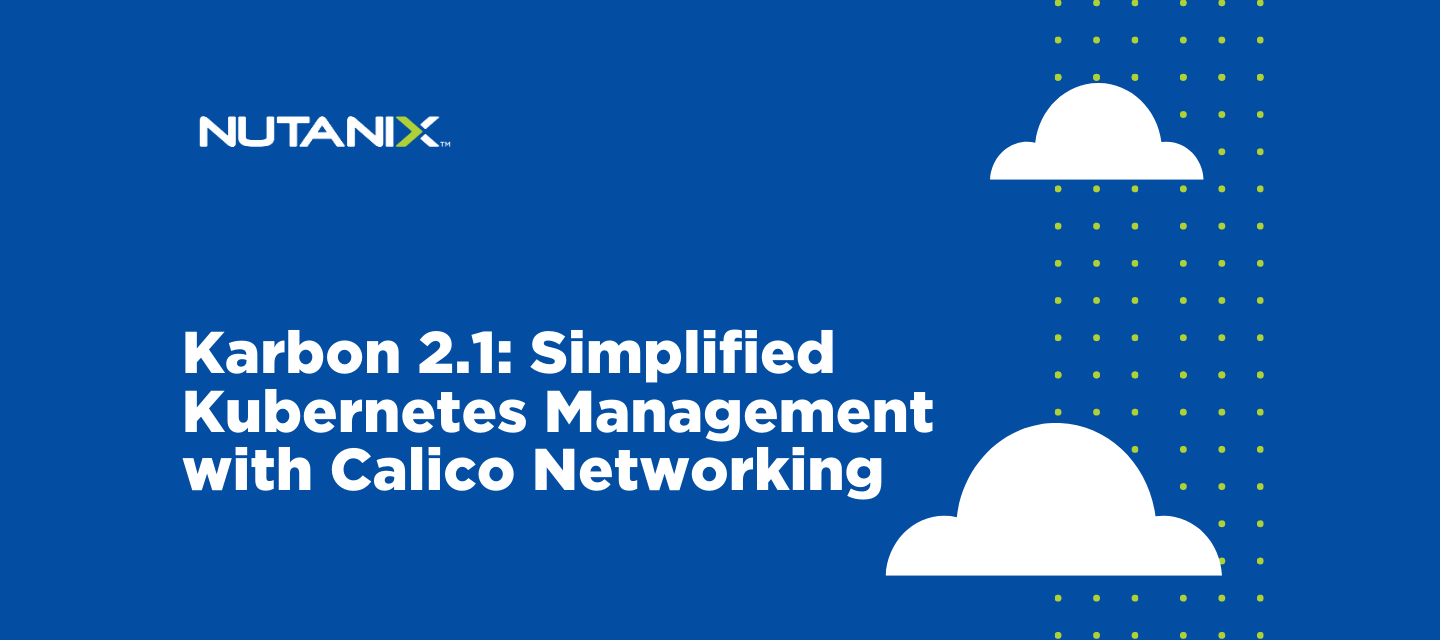This post was authored by Sean Roth, Director of Product Marketing - Karbon | Cloud Native Solutions
Hot on the heels of the recent Karbon 2.0 release, which delivered single-click Kubernetes upgrades, support for air-gapped environments, and integration with Prism Pro for a single-pane-of-glass user experience, Nutanix is excited to announce the availability of Karbon 2.1!
In this latest release, we’ve focused on tackling two of Kubernetes’ most difficult challenges: networking and storage.
Calico Integration
Networking Kubernetes pods and making them accessible to other services or external networks can be a complicated undertaking, often requiring the use of overlay networks and NATs. At scale, this becomes extremely complex. Many cloud native enterprises seeking a consistent container networking experience, along with capabilities that apply across different Kubernetes environments, have turned to Calico.
Calico combines flexible networking capabilities with run-anywhere security enforcement to provide a solution with native Linux kernel performance and true cloud-native scalability. As such, it has become the de facto standard in open-source Kubernetes networking technologies, and one which many of our customers using Karbon have demanded. With that feedback, we now offer Calico as an integrated component of Karbon.
With this integration, Karbon users can now take advantage of simplified Kubernetes networking based on native tooling that provides better throughput as compared to Flannel or an overlay-based network plugin. Because Calico leverages standard networking tools and well-known protocols, troubleshooting is significantly easier for network and sysadmins, who can comfortably rely on their existing knowledge and experience.
Furthermore, Calico offers a straightforward means of implementing network security policies. For example, users can isolate pods from one another and restrict access to and from the application. Overall, users have finer network control directly at the application deployment level.
Karbon’s integration of Calico has also culminated in a formal technology alliance with Tigera, which is the inventor and primary maintainer of Project Calico. Tigera is an open-core company offering Calico Enterprise, which builds on the open-source Project Calico to include features that help multiple teams and enterprises operate Kubernetes in a secure production environment. The company’s technology is deployed in the largest SaaS, financial services, gaming, and retail companies where security and compliance are critical to the business.
“We’re excited about our partnership with Nutanix and with their decision to standardize on Calico as the default CNI for Karbon,” said Amit Gupta, Tigera’s VP of Product Management and Business Development. “By bringing Calico’s run-anywhere security enforcement to Karbon customers, developers and cluster operators enjoy a consistent experience and set of capabilities accelerating their Kubernetes journey.”
CSI Volume Cloning and Expansion
Volume cloning is a key data protection capability that has recently been implemented in Kubernetes. According to the Kubernetes user documentation, the CSI (Container Storage Interface) Volume Cloning feature adds support for specifying existing PVCs in the dataSource field to indicate a user would like to clone a volume. When a volume is cloned in Kubernetes, an exact duplicate of the specified volume is created and can be used in the same ways as the original volume.
By adding volume cloning as a feature in our own CSI (included with Karbon), users can take full advantage of Nutanix’s space-efficient cloning technology. With Nutanix, application data is seeded into the application at creation time, which reduces setup time and overall space usage. Furthermore, if the application using the cloned volume requires a larger volume size, the CSI driver will then increase the size of the cloned volume accordingly.
The ability to clone volumes delivers a path for users to rapidly troubleshoot stateful containerized applications. It enables them to instantly duplicate the data of a running application in order to diagnose an issue or test a new version of the application.
Expanded APIs
With Karbon 2.1, users can further leverage their preferred tools and portals for executing Karbon workflows. Kubernetes clusters can be created in a self-service fashion via Nutanix Calm, ServiceNow, or any other portal that can issue API calls.
Through Karbon’s enhanced APIs, users can provision Kubernetes clusters on-demand (per developer, per project, etc.), and automate gathering of kubeconfig files for a given cluster. It is now also possible to automate SSH access to cluster nodes, which is useful for debugging purposes.
Take Karbon for a Test Drive
If you’re considering deploying Karbon on Nutanix for the foundation of your cloud-native environment, take Karbon for a full test drive! The recently launched Nutanix Test Drive program puts you in the driver’s seat of Karbon on a live cluster, letting you experience how smooth and simple Karbon makes Kubernetes cluster deployment, storage configuration, and upgrades. Sign up to take a spin!
Have questions, or share some of the cool things you are doing with Karbon in the community forums.
© 2020 Nutanix, Inc. All rights reserved. Nutanix, the Nutanix logo and all Nutanix product, feature and service names mentioned herein are registered trademarks or trademarks of Nutanix, Inc. in the United States and other countries. All other brand names mentioned herein are for identification purposes only and may be the trademarks of their respective holder(s). This post may contain links to external websites that are not part of Nutanix.com. Nutanix does not control these sites and disclaims all responsibility for the content or accuracy of any external site. Our decision to link to an external site should not be considered an endorsement of any content on such a site.
This post may contain express and implied forward-looking statements, which are not historical facts and are instead based on our current expectations, estimates and beliefs. The accuracy of such statements involves risks and uncertainties and depends upon future events, including those that may be beyond our control, and actual results may differ materially and adversely from those anticipated or implied by such statements. Any forward-looking statements included herein speak only as of the date hereof and, except as required by law, we assume no obligation to update or otherwise revise any of such forward-looking statements to reflect subsequent events or circumstances.


